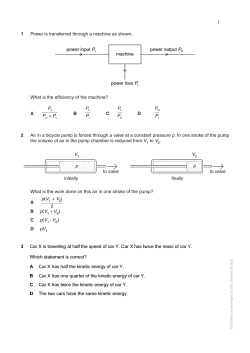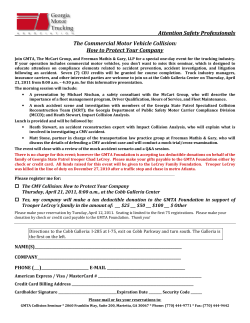
How to (almost!) derive the essential concepts of
How to (almost!) derive the essential concepts of General Relativity from a single collision Roy Lisker rlisker@yahoo.com May 7, 2013 All of General Relativity derives from Special Relativity combined with the Equivalence Principle. That combination leads one to the formalism of Differential Geometry and the interpretation of gravity as the curvature of Space-‐‑Time. This being so, it is essential that one understands what the Equivalence Principle is actually saying. There are several equivalent (sic) formulations: (1) Gravitational Mass is identical with Inertial Mass. It was the experimental confirmation of this by the experiments Eötvös and his team at the end of the 19th century that led Einstein to think along the lines that led to the invention of General Relativity. (2) There is no way that an observer located on a system in “free 2 fall” in a gravitational field can detect its own motion. This follows from (1) and from the corresponding theorem of Special Relativity: there is no way in which an observer in a given inertial reference frame can detect any motion of that reference frame. What has been added is the concept of “weighlessness”, now a commonplace in the space age. A “massive observer” has no weight on its own trajectory. The properties do not apply to accelerations due to forces other than gravitation. For example, a charged observer accelerating under the effect of a Coulomb force can observe that particles of the charge opposite to its own will be moving in the opposite direction, or even appear to be standing still, that neutral particles will be unaffected, and that differences in the masses of charged particles will result in differing accelerations based not on mass alone but also on charge. One can also interpret weightlessness to the converse proposition: (3) A force that acts equally on all particles of matter (fermions) must be gravity. Otherwise state, Gravitation is the geometry of Space-‐‑ Time. 3 (4) Specifically, a gravitational field is a local curvature in the Space-‐‑Time geometry. This manifests itself in terms of a measurable deviation from a Euclidean geometry of space, and a Minkowski geometry of space-‐‑time. What General Relativity does, in effect, is to extend the notion of the reference frame for all observers, in a universe of uniform relative linear motion, to the notion of the reference frame for all massive objects which, by their nature, set up gravitational fields. This is what is meant by the equivalence: “Gravitational Mass = Inertial Mass”. The way it does this is to generalize Euclidean Geometry to non-‐‑ Euclidean Geometry in such a manner that, barring the presence of other forces, all paths are inertial paths in some appropriate non-‐‑Euclidean geometry. For example, it is believed that “dark matter” is a form of matter, that is to say, fermions rather than bosons, because of its gravitational effect on galaxies and gravitational clusters. By the Pauli Exclusion Principle, 4 fermions must be “particulate”, hence the on-‐‑going search for particles of dark matter. Collisions There is another way of interpreting the expression “to act equally on all massive bodies”, which is present in the phenomenon of collisions. The effect of a collision of mass X with mass Y on the mass Y is that it transfers all of the momentum of X to Y. Equally, all of the momentum of Y is transferred to X. As an acceleration is defines to be any change of velocity, it follows that collisions impart “accelerations” to both of the impinging bodies. Accelerations need not be differentiable nor continuous. In a collision the acceleration becomes infinite for one split second. Mathematically, the acceleration between two bodies with masses M1 and M2 under a mutual gravitational attraction is (for a fixed distance r), a function of the difference M1 – M2, whereas in an inertial collision, the instantaneous acceleration is a function of M1/M2 . 5 Since both theories of relativity are formulated in the language of differential geometry, every quantity that enters into a relativistic formula should be differentiable to at least the third degree. Yet the continuity of the derivative breaks down at in a collision: collisions are singularities. Neither Special nor General Relativity have anything to say about collisions. Indeed, collisions appear to operate outside their theoretical frameworks. Special Relativity assumes that all observers are at rest in their own rest-‐‑frames: it cannot deal with the situation in which these frames collide. Likewise in General Relativity, observers in continuous trajectories are weightless in their own frame. But what happens when they collide? Curiously, the science of Statistical Mechanics is entirely based on collisions!! The change in momentum at a collision is translated into a finite change on all velocities. This must be treated as a real force on each of the colliding masses. Through a natural extension of General Relativity, a collision is a singular, instantaneous manifestation of a gravitational field.1 1 As pointed out by John Archibald Wheeler, one of the principal stumbling blocks to a theory of Quantum Gravity, is that the “quantities” of General Relativity, curvature and metric, are second or third order differentiable, whereas the quantities of Quantum Field Theory, the fermions, are discrete objects of half-‐integral spin. 6 In addition to acknowledging that Gravity = Inertia, we seem to be saying Inertia=Gravitation! Let us examine the consequences. Suppose that we try to extend the notion that any material body in our universe, subject only to inertia and gravity, can always be described as being at rest in its own frame, how should collisions be interpreted? Let there be given 3 observers: J, O and P. J and O establish that they are in the same rest-‐‑frame. O is sitting on a mass N, P on a mass M, while J is simply some “outside observer” of the interaction of O and P. To J, P is speeding, directly in a straight line towards O at a velocity v. Relative to J, the momenta before the collision are “0” for O, and “– Mv” for J. After the collision, by a familiar calculation, J is still at rest (one neglects the gravitational pull between the masses). Relative to J the other objects are moving away from each other, with velocity v1 for O, v2 for P, given by 2M v M+N M −N v2 = v M+N v1 = € 7 The observer on O sees things very differently. Since he is always at rest in his own frame, he will speak in terms of some instantaneous gravitational force that has added a velocity v1, equally to everything else in the universe (except for the impinging P, moving away at the velocity v!). General Relativity allows O to claim that he never moves, like the joke about the English married couple. What has happened is that there has been an instantaneous change in the curvature of space-‐‑time! This change in curvature has put a “kink” into all of the “straight lines” of the space-‐‑time diagrams!! Where “is” this gravitational force? It appears to be coming from far away, from the edge of the universe, possibility from infinity. In some sense it affects all things “instantly”. From the viewpoint of O, his own mass (or equivalent energy) is unchanged: weightless he was at the beginning, and weightless he shall remain, save for one brief moment in which he had a Moment. (Or, as Archimedes said to the Roman soldier who insisted that he stop his research and follow him, “Just a Moment.”) 8 Yet it is at this point that a problem arises. According to Special Relativity, one cannot speak of a force acting “simultaneously” on objects at widely dispersed distances from a fixed observer. But Special Relativity also provides the answer: O’s information about the velocities of other, more distant objects can only come to him through light signals whose speed are limited by the speed of light. Thus, there will be a delay in k light-‐‑years in the information coming from a star S, k light-‐‑years away, which will let O know that a “kick” in the amount (2M/M+N)v was administered to S at some moment in time. Consequently, there is an epistemological gap between the moment that J moved away with velocity v1, and the light arrives from S telling O that it has been similarly affected. In the intervening interval O can know nothing about the alteration of the velocity of S, which is to say its acceleration. From the viewpoint of the observer P, with mass M, the situation is being viewed co-‐‑variantly. P will also observe that he has somehow “hopped into” another reference frame at the time of the collision. In this 9 reference frame, all objects have been given an additional velocity v2 = (2N/M+N) v. P’s analysis is identical to that of O, save that it is co-‐‑variant, not symmetrical, unless M=N. Covariance is expressed in the phenomenon of weight. Although O sees himself as weightless, he attributes to P a weight (or mass) of M. P likewise attributes to O a weight of N, while seeing himself as weightless. Away from the collision, each sees himself as being in free fall. Gravity, Light and Gravity Waves Reinterpreting the collision as a kind of gravity leads to the conclusion that gravity must travel at the speed of light. It takes the same time for the information of the acceleration effect on S, which is gravitational, to travel to O, as does the light signal conveying this information. (This restriction may not apply to Dark Matter: see On the Hubble Expansion: http://www.fermentmagazine.org/expansion.pdf 10 From Quantum Field Theory we know that this information must be in the form of a wave, that is to say a boson. We have thus deduced gravitational waves. Summary From the analysis of a simple collision, we have derived all of these features of General Relativity: (1) The inertial effects of a collision can be interpreted as a gravitational interaction (2) The warping of curvature by the collision is translated into a kink in the world lines of O and P. These kinks are very different but related by co-‐‑variance. (3) The situations of O and P are similarly structured yet very different. Rather than “invariance” one has “covariance” (4) Gravity travels at the speed of light (5) There have to be gravity waves. 11 Commentary May 6, 2013: Clearly, interpreting collisions as singular accelerations, therefore as manifestations of gravitation, needs more justification. Right away one sees that the impinging body (P, M) flies off, relative to (O, N) at a velocity v, whereas the rest of the universe flies off at a velocity v1 = (2M/M+N) v. Thus the "ʺinertial force"ʺ of a collision acts differently on different massive bodies. However there is a deep insight contained in this, which implies in fact that the Equivalence Principle is “incorrect as stated"ʺ. The assertion that Inertial and Gravitational Mass are equal is very misleading. In fact, ALL inertial effects are based on the RATIOS of the masses involved, whereas gravitational effects are based on the ABSOLUTE values of the masses relative to the gravitational constant G. In other words if, in a collision situation, all the masses are doubled, then all the effects remain the same. Whereas in a gravitational attraction, if the masses of both bodies are doubled, the acceleration on each is doubled. Thus, Inertial mass is a relative quantity, that is to say a magnitude, and can be treated like length. To set up a system for measuring masses, one 12 arbitrarily picks some “unit mass”, m, then obtains the masses of other objects by measuring the velocities that come out of collisions. Gravitational mass however is relative, not to other masses, but to the universal gravitational constant. So inertial and gravitational mass are equivalent only in the sense that the units in which mass is measured are taken from gravitational mass. In fact it is easily shown that, setting both the gravitational constant and speed of light conveniently to “1”, that gravitational mass is measured in units of length. The notion of a "ʺforce which acts on all matter equally"ʺ has different meanings in the context of gravitation and inertia, and they cannot be considered “equivalent.” That collisions are indeed “force” interactions can be seen from the attributes of temperature, heat and entropy. ********************************************************* 13
© Copyright 2025





















